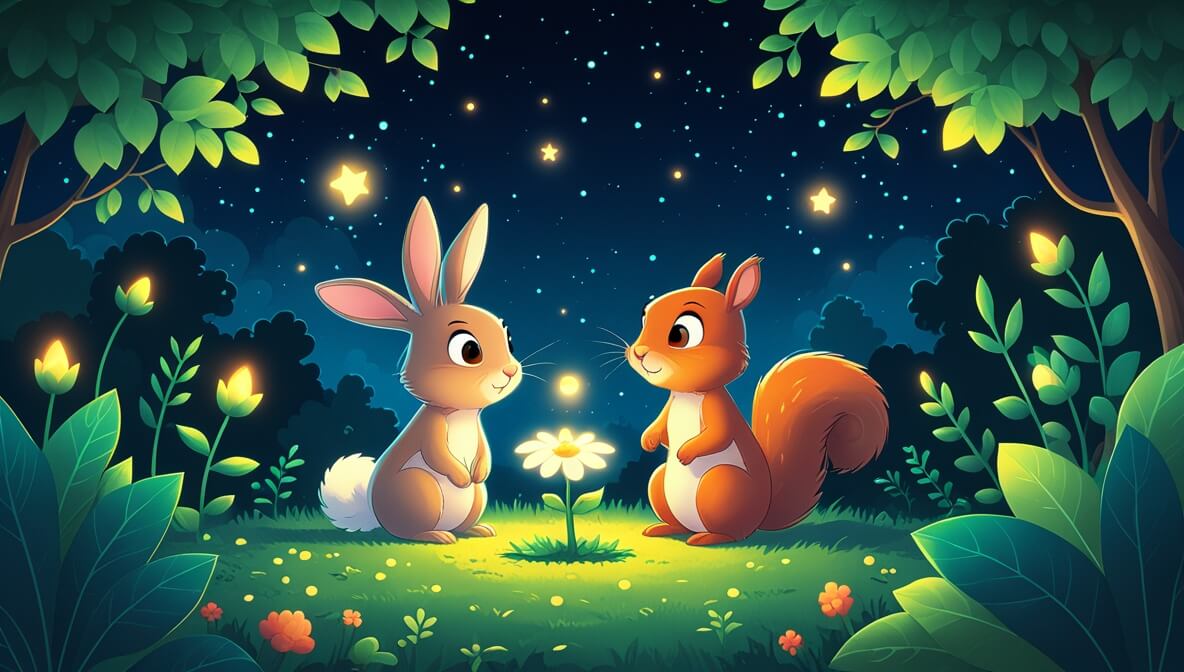In a cozy little garden, a friendly bunny and a curious squirrel embark on a small adventure to find the magical moonflower, a blossom that only blooms at night. Along the way, they discover the joy of friendship and the wonders of nature.
Age Recommendation
0 – 4 years
Characters
Characters:
- Whiskers (a friendly bunny with a love for exploring)
- Nibbles (a curious squirrel who loves to learn new things)
Story
On a warm evening, as the sun began to set, **Whiskers** the bunny hopped around the garden, his fluffy tail bouncing behind him. He noticed his friend, **Nibbles** the squirrel, peeking out from a tree branch. “Hello, Whiskers!” called Nibbles. “Did you hear about the **magical moonflower**? It’s supposed to bloom tonight!”
The Quest Begins
Whiskers’ eyes widened with excitement. “Really? Let’s go find it together! I love flowers,” he said. Together, Whiskers and Nibbles set off on their **moonflower quest**, guided by the glow of the first evening stars. They giggled and chatted, hopping and scampering through the garden paths.
Discovering the Glow
As they journeyed deeper into the garden, the soft **moonlight** illuminated their path. Suddenly, Nibbles pointed ahead. “Look, Whiskers! There it is!” Nestled among the leaves was the **moonflower**, its petals shimmering like tiny stars. “It’s so beautiful,” whispered Whiskers.
A Special Friendship
They sat together, watching the moonflower bloom under the **night sky**. “I’m glad we found it together,” said Nibbles, smiling at his friend. Whiskers nodded, feeling happy and warm. “Me too, Nibbles. You’re the best **adventure buddy**!”
The end.
Moral of the Story
Friendship makes every adventure better, and exploring the world together can reveal the beauty of nature and the joy of companionship.
Questions to Think About
- What would you do if you found a magical flower?
- How can you be a good friend like Whiskers and Nibbles?
- What other adventures could Whiskers and Nibbles go on?
- Why is it special to explore with a friend?
- Describe a time when you found something new and exciting.
Do You Know
- Moonflowers really exist! They bloom at night and have a sweet smell.
- Squirrels’ teeth never stop growing, so they have to keep nibbling to make sure they don’t get too long!
Word Explorer
- Moonflower: A flower that blooms at night.
- Adventure: A fun and exciting journey.
- Companion: A friend who shares your journey.
Emotions in the Story
- Excitement: Whiskers felt this when he learned about the magical moonflower.
- Curiosity: Nibbles felt this when he wanted to find the moonflower.
- Happiness: Both felt happy when they found the moonflower together.
Color Your Scene
Imagine the garden under the night sky, filled with twinkling stars and the shimmering moonflower. Draw Whiskers and Nibbles sitting together, surrounded by the soft glow of the moonlight. Use colors like bright yellow for the moonflower, deep blue for the night sky, and green for the garden.
Parents’ Corner
This story is a wonderful opportunity to talk to your child about:
Friendship: Discuss how Whiskers and Nibbles support each other and how your child can be a good friend.
Exploration: Encourage your child to explore their surroundings and learn about nature, fostering a sense of curiosity and wonder.
Appreciation of Nature: Highlight the beauty found in simple things like flowers, stars, and friendships.
Working Together: Talk about how working together can make experiences more enjoyable and successful.











